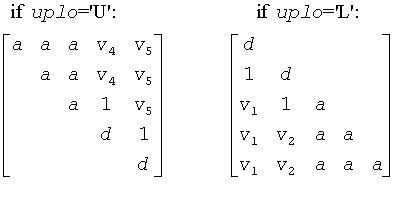Visible to Intel only — GUID: GUID-970AA850-96E7-47ED-9200-7A6EADAE1D0E
Visible to Intel only — GUID: GUID-970AA850-96E7-47ED-9200-7A6EADAE1D0E
p?latrd
Reduces the first nb rows and columns of a symmetric/Hermitian matrix A to real tridiagonal form by an orthogonal/unitary similarity transformation.
Syntax
call pslatrd(uplo, n, nb, a, ia, ja, desca, d, e, tau, w, iw, jw, descw, work)
call pdlatrd(uplo, n, nb, a, ia, ja, desca, d, e, tau, w, iw, jw, descw, work)
call pclatrd(uplo, n, nb, a, ia, ja, desca, d, e, tau, w, iw, jw, descw, work)
call pzlatrd(uplo, n, nb, a, ia, ja, desca, d, e, tau, w, iw, jw, descw, work)
Description
The p?latrdroutine reduces nb rows and columns of a real symmetric or complex Hermitian matrix sub(A)= A(ia:ia+n-1, ja:ja+n-1) to symmetric/complex tridiagonal form by an orthogonal/unitary similarity transformation Q'*sub(A)*Q, and returns the matrices V and W, which are needed to apply the transformation to the unreduced part of sub(A).
If uplo = U, p?latrd reduces the last nb rows and columns of a matrix, of which the upper triangle is supplied;
if uplo = L, p?latrd reduces the first nb rows and columns of a matrix, of which the lower triangle is supplied.
Input Parameters
- uplo
-
(global) CHARACTER.
Specifies whether the upper or lower triangular part of the symmetric/Hermitian matrix sub(A) is stored:
= 'U': Upper triangular
= L: Lower triangular.
- n
-
(global) INTEGER.
The number of rows and columns to be operated on, that is, the order of the distributed matrix sub(A). n ≥ 0.
- nb
-
(global) INTEGER.
The number of rows and columns to be reduced.
- a
-
REAL for pslatrd
DOUBLE PRECISION for pdlatrd
COMPLEX for pclatrd
COMPLEX*16 for pzlatrd.
Pointer into the local memory to an array of size (lld_a, LOCc(ja+n-1)).
On entry, this array contains the local pieces of the symmetric/Hermitian distributed matrix sub(A).
If uplo = U, the leading n-by-n upper triangular part of sub(A) contains the upper triangular part of the matrix, and its strictly lower triangular part is not referenced.
If uplo = L, the leading n-by-n lower triangular part of sub(A) contains the lower triangular part of the matrix, and its strictly upper triangular part is not referenced.
- ia
-
(global) INTEGER.
The row index in the global matrix A indicating the first row of sub(A).
- ja
-
(global) INTEGER.
The column index in the global matrix A indicating the first column of sub(A).
- desca
-
(global and local) INTEGER array of size dlen_. The array descriptor for the distributed matrix A.
- iw
-
(global) INTEGER.
The row index in the global matrix W indicating the first row of sub(W).
- jw
-
(global) INTEGER.
The column index in the global matrix W indicating the first column of sub(W).
- descw
-
(global and local) INTEGER array of size dlen_. The array descriptor for the distributed matrix W.
- work
-
(local)
REAL for pslatrd
DOUBLE PRECISION for pdlatrd
COMPLEX for pclatrd
COMPLEX*16 for pzlatrd.
Workspace array of size nb_a.
Output Parameters
- a
-
(local)
On exit, if uplo = 'U', the last nb columns have been reduced to tridiagonal form, with the diagonal elements overwriting the diagonal elements of sub(A); the elements above the diagonal with the array tau represent the orthogonal/unitary matrix Q as a product of elementary reflectors;
if uplo = 'L', the first nb columns have been reduced to tridiagonal form, with the diagonal elements overwriting the diagonal elements of sub(A); the elements below the diagonal with the array tau represent the orthogonal/unitary matrix Q as a product of elementary reflectors.
- d
-
(local)
REAL for pslatrd/pclatrd
DOUBLE PRECISION for pdlatrd/pzlatrd.
Array of size LOCc(ja+n-1).
The diagonal elements of the tridiagonal matrix T: d(i) = a(i,i). d is tied to the distributed matrix A.
- e
-
(local)
REAL for pslatrd/pclatrd
DOUBLE PRECISION for pdlatrd/pzlatrd.
Array of size LOCc(ja+n-1) if uplo = 'U', LOCc(ja+n-2) otherwise.
The off-diagonal elements of the tridiagonal matrix T:
e(i) = a(i, i + 1) if uplo = 'U',
e(i) = a(i + 1, i) if uplo = 'L'.
e is tied to the distributed matrix A.
- tau
-
(local)
REAL for pslatrd
DOUBLE PRECISION for pdlatrd
COMPLEX for pclatrd
COMPLEX*16 for pzlatrd.
Array of size LOCc(ja+n-1). This array contains the scalar factors of the elementary reflectors. tau is tied to the distributed matrix A.
- w
-
(local)
REAL for pslatrd
DOUBLE PRECISION for pdlatrd
COMPLEX for pclatrd
COMPLEX*16 for pzlatrd.
Pointer into the local memory to an array of size lld_wby nb_w. This array contains the local pieces of the n-by-nb_w matrix w required to update the unreduced part of sub(A).
Application Notes
If uplo = 'U', the matrix Q is represented as a product of elementary reflectors
Q = H(n)*H(n-1)*...*H(n-nb+1)
Each H(i) has the form
H(i) = I - tau*v*v' ,
where tau is a real/complex scalar, and v is a real/complex vector with v(i:n) = 0 and v(i-1) = 1; v(1:i-1) is stored on exit in A(ia:ia+i-1, ja+i), and tau in tau(ja+i-1).
If uplo = L, the matrix Q is represented as a product of elementary reflectors
Q = H(1)*H(2)*...*H(nb)
Each H(i) has the form
H(i) = I - tau*v*v' ,
where tau is a real/complex scalar, and v is a real/complex vector with v(1:i) = 0 and v(i+1) = 1; v(i+2: n) is stored on exit in A(ia+i+1: ia+n-1, ja+i-1), and tau in tau(ja+i-1).
The elements of the vectors v together form the n-by-nb matrix V which is needed, with W, to apply the transformation to the unreduced part of the matrix, using a symmetric/Hermitian rank-2k update of the form:
sub(A) := sub(A)-vw'-wv'.
The contents of a on exit are illustrated by the following examples with
n = 5 and nb = 2:

where d denotes a diagonal element of the reduced matrix, a denotes an element of the original matrix that is unchanged, and vi denotes an element of the vector defining H(i).